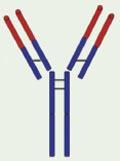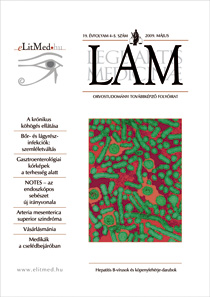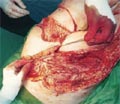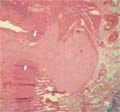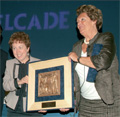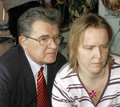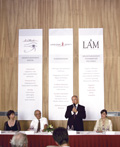The eLitMed.hu medical portal uses computer cookies for convenient operation. Detailed information can be found in the Cookie-policy.
Lege Artis Medicinae - 2009;19(04-05)
Content
[Focus on the diagnosis and therapy of chronic cough]
[Cough by itself is not a disease but a part of a complex defense mechanism protecting from harmful materials entering the airways and cleaning the lungs and airways from potentially harmful materials. Normally, cough is accompanied by other defense mechanisms (bronchoconstriction and secretion of sputum) that increase the effectiveness of cough. Cough generally is caused by intrapulmonary disorders, but may be related to extrapulmonary lesions that are not easy to diagnose. In every case, an etiological diagnosis has to be the aim because this is the only way to proper treatment. From the abundance of reasons for cough, upper airway cough syndrome, asthma, chronic obstructive pulmonary disease, and gastro-esophageal reflux disease are discussed in detail.]
[Tumor necrosis factor-alpha blockade: adverse clinical consequences and safety issues]
[The pleiotropic cytokine tumor necrosis factor (TNF)-α seems to be fundamentally involved in the pathogenesis of a variety of immune-mediated (partly autoimmune) chronic inflammatory disorders; therefore, its blockade has allowed a remarkable advance in treatment strategies. Safety and tolerability profile of TNF-antagonists is generally favorable, their overall risk/benefit ratio is definitely positive. Possible adverse consequences related to TNF-α blocking monoclonal antibodies and soluble receptors can be classified as class-specific side effects that are related to their mode of action, and individual, molecule-specific effects. Immunogenic potential of immunoglobulins (Ig) eliciting an anti-(Ig-) antibody immune response may reduce or eliminate their therapeutic benefit, increase the risk of resistance or intolerance to biologic agents, and also lead to other adverse clinical effects. The immunogenicity profile of TNFantagonists is mainly related to their hetero- (xeno-), allo- (iso-)genic or idiotypic antigen character. By means of generating fully human monoclonal antibodies, more tolerable drugs could be introduced into clinical practice.]
[Necessity of a shift in attitudes in the judgment and therapy of skin and soft-tissue infections]
[Skin and soft-tissue infections are defined as infections of the epidermis, dermis, or subcutan tissue. They are among the most common human bacterial infections observed in clinical practice. It has also been shown that the incidence of skin and soft-tissue infections is increasing. This has been attributed to several factors, including increasing population age, surgical wounds related to more invasive surgery in the ageing population, obesity, malnutrition, diabetes, peripheral vascular disease and decreasing immunocompetence. There has been a major increase in the occurrence of Staphylococcus aureus infections, and communityacquired methicillin-resistant S. aureus (MRSA) infections in particular. Although many cases of skin and soft-tissue infections can be successfully treated using empirical antimicrobial therapy, changing resistance patterns of S. aureus isolates necessitate new treatment strategies.]
[Enigma abdominalis - superior mesenteric artery syndrome]
[INTRODUCTION - Superior mesenteric artery syndrome is caused by vascular compression of the inferior transverse part of the duodenum due to the anomalous course of the superior mesenteric artery and/or a cranial shortening of the ligament of Treitz. Clinical caracteristics include postprandial epigastric pain, nausea, vomiting of bile, slow passage in the gastroduodenal passage, and as a consequence of the above, pernicious weight loss. CASE REPORT - In the case of a 35-year old woman with chronic abdominal symptoms for 6 years and 20 kg weight loss, CT-enterography revealed superior mesenteric artery syndrome. We identified an abnormally acute aortomesenteric angle of 7.3 degrees and a highly inserted ligament of Treitz as predisposing factors. We presume that the immediate cause of the development of severe vascular compression, in the case of our patient, was progressive weight loss due to a persistent Epstein-Barr virus infection. CONCLUSION - First in Hungarian literature we review the etiology, the radiological signs, the procedure of differential diagnosis, and the treatment options of superior mesenteric artery syndrome.]
[Isolated anal form of Crohn’s disease with an extensive perianal septic complication]
[INTRODUCTION - Perianal manifestations of Crohn’s disease are common. Treatment of advanced complications like strictures and incontinence may require a radical surgical intervention. We present a case of an extremely rare manifestation of Crohn’s disease. The disease localized exclusively to the anal canal for more than twenty years was complicated by an extensive perianal septic lesion. Besides our own surgical strategy, we discuss in detail other therapeutic options for perianal septic complications of Crohn’s disease. CASE REPORT - During 16 years of disease course the perianal process of the 34 year old female patient caused sphincter destruction and incontinence, and furthermore resulted in a chronic septic state by fistulous tracts involving the whole perineo-gluteal region. Following rectal extirpation, we performed a radical excision and a reconstructive operation using musculo- cutaneous/fascio-cutaneous advancement flaps. The final result of multiple operations of two years’ duration was functionally and aesthetically excellent. CONCLUSION - Fistulous tracts of perianal Crohn’s disease destructing widely their surroundings can only be cured by the radical excision of involved tissues. Extremely large consequent defects can also be covered with proper functional results by methods applying healthy tissues of good loadability i.e. musculocutaneous/ fascio-cutaneous advancement flaps.]
[Successful treatment of chronic hepatitis C infection accompanied by rare but reversible adverse effects]
[INTRODUCTION - In absence of signs and symptoms characteristic of chronic hepatic disease caused by hepatitis C viral infection, its diagnosis is generally suggested by abnormal liver function tests. If viral serological activity is confirmed, combined antiviral treatment (pegylated interferon plus ribavirin) has to be considered. Antiviral treatment is accompanied by several, usually reversible adverse effects. CASE REPORT - The 62 year-old woman has had waveringly abnormal liver function results for decades. Her anamnesis included transfusions for polytraumatization that resulted in a hepatitis C virus infection. We started treatment with interferon alpha-2a plus ribavirin. At week 4 of therapy, a significant decrease in virulence and at week 12, viral negativity was confirmed, accompanied by a normalization of hepatic function markers. Because of a gradually developing anemia, beginning from month 4, the former optimal dose of ribavirin had to be reduced. At the end of week 42, severe dermatitis with fever, muscle weakness and malaise (Sweetsyndrome) developed, and antiviral therapy had to be discontinued and steroids had to be given. During a short travel abroad, the patient suffered a collaptiform episode caused by extremely high blood glucose (28.0 mmol/l). She received temporarily fractioned insulin and then combined oral antidiabetic treatment. Then, dermatosis symptoms rapidly resolved, glycemic status gradually improved, and could be controlled by low-dose metformin. Liver function tests were normal. At the end of antiretroviral treatment and 6 months later, HCV-RNA by PCR proved negative, meaning that hepatitis C virus has been eradicated successfully. CONCLUSION - Treatment with pegylated interferon alpha-2a plus ribavirin rendered viral replication undetectable at 3 months, which is - together with the normalization of abnormal liver function tests - the strongest predictor of a good outcome. The patient’s exemplary good compliance contributed to successful treatment of hepatitis C and control of these rare but reversible adverse effects.]
1.
Clinical Neuroscience
[Headache registry in Szeged: Experiences regarding to migraine patients]2.
Clinical Neuroscience
[The new target population of stroke awareness campaign: Kindergarten students ]3.
Clinical Neuroscience
Is there any difference in mortality rates of atrial fibrillation detected before or after ischemic stroke?4.
Clinical Neuroscience
Factors influencing the level of stigma in Parkinson’s disease in western Turkey5.
Clinical Neuroscience
[The effects of demographic and clinical factors on the severity of poststroke aphasia]1.
2.
Clinical Oncology
[Pancreatic cancer: ESMO Clinical Practice Guideline for diagnosis, treatment and follow-up]3.
Clinical Oncology
[Pharmacovigilance landscape – Lessons from the past and opportunities for future]4.
5.





